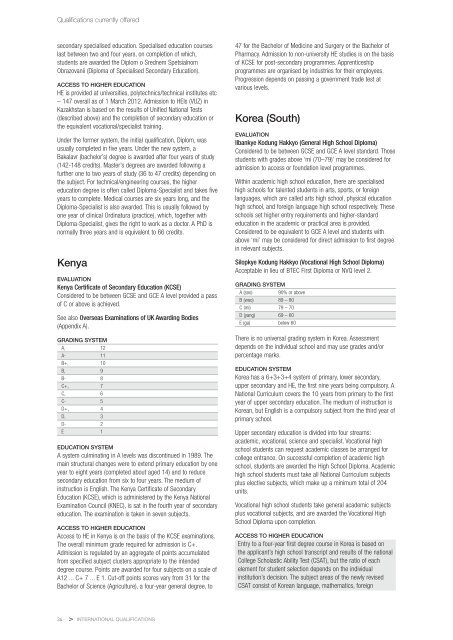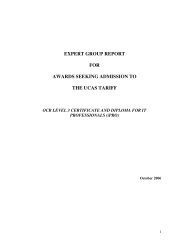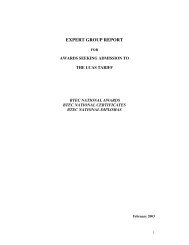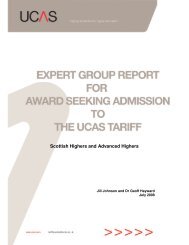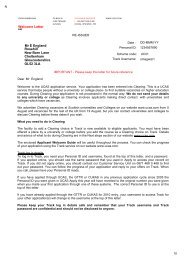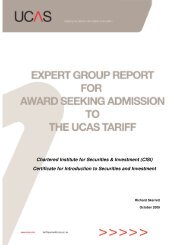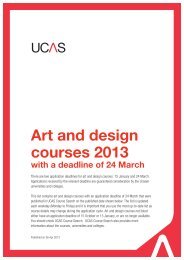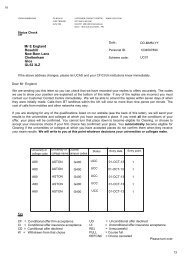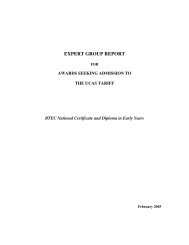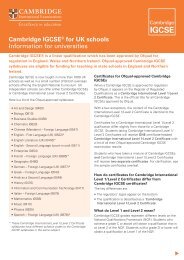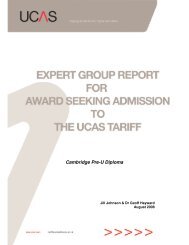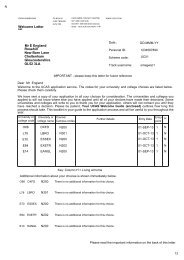International qualifications 2013 (pdf) - CUKAS
International qualifications 2013 (pdf) - CUKAS
International qualifications 2013 (pdf) - CUKAS
Create successful ePaper yourself
Turn your PDF publications into a flip-book with our unique Google optimized e-Paper software.
Qualifications currently offered<br />
secondary specialised education. Specialised education courses<br />
last between two and four years, on completion of which,<br />
students are awarded the Diplom o Srednem Spetsialnom<br />
Obrazovanii (Diploma of Specialised Secondary Education).<br />
ACCESS TO HIGHER EDUCATION<br />
HE is provided at universities, polytechnics/technical institutes etc<br />
– 147 overall as of 1 March 2012. Admission to HEIs (VUZ) in<br />
Kazakhstan is based on the results of Unified National Tests<br />
(described above) and the completion of secondary education or<br />
the equivalent vocational/specialist training.<br />
Under the former system, the initial qualification, Diplom, was<br />
usually completed in five years. Under the new system, a<br />
Bakalavr (bachelor’s) degree is awarded after four years of study<br />
(142-148 credits). Master’s degrees are awarded following a<br />
further one to two years of study (36 to 47 credits) depending on<br />
the subject. For technical/engineering courses, the higher<br />
education degree is often called Diploma-Specialist and takes five<br />
years to complete. Medical courses are six years long, and the<br />
Diploma-Specialist is also awarded. This is usually followed by<br />
one year of clinical Ordinatura (practice), which, together with<br />
Diploma-Specialist, gives the right to work as a doctor. A PhD is<br />
normally three years and is equivalent to 66 credits.<br />
Kenya<br />
EVALUATION<br />
Kenya Certificate of Secondary Education (KCSE)<br />
Considered to be between GCSE and GCE A level provided a pass<br />
of C or above is achieved.<br />
See also Overseas Examinations of UK Awarding Bodies<br />
(Appendix A).<br />
GRADING SYSTEM<br />
A, 12<br />
A- 11<br />
B+, 10<br />
B, 9<br />
B- 8<br />
C+, 7<br />
C, 6<br />
C- 5<br />
D+, 4<br />
D, 3<br />
D- 2<br />
E 1<br />
EDUCATION SYSTEM<br />
A system culminating in A levels was discontinued in 1989. The<br />
main structural changes were to extend primary education by one<br />
year to eight years (completed about aged 14) and to reduce<br />
secondary education from six to four years. The medium of<br />
instruction is English. The Kenya Certificate of Secondary<br />
Education (KCSE), which is administered by the Kenya National<br />
Examination Council (KNEC), is sat in the fourth year of secondary<br />
education. The examination is taken in seven subjects.<br />
ACCESS TO HIGHER EDUCATION<br />
Access to HE in Kenya is on the basis of the KCSE examinations.<br />
The overall minimum grade required for admission is C+.<br />
Admission is regulated by an aggregate of points accumulated<br />
from specified subject clusters appropriate to the intended<br />
degree course. Points are awarded for four subjects on a scale of<br />
A12 ... C+ 7 ... E 1. Cut-off points scores vary from 31 for the<br />
Bachelor of Science (Agriculture), a four-year general degree, to<br />
47 for the Bachelor of Medicine and Surgery or the Bachelor of<br />
Pharmacy. Admission to non-university HE studies is on the basis<br />
of KCSE for post-secondary programmes. Apprenticeship<br />
programmes are organised by industries for their employees.<br />
Progression depends on passing a government trade test at<br />
various levels.<br />
Korea (South)<br />
EVALUATION<br />
Ilbankye Kodung Hakkyo (General High School Diploma)<br />
Considered to be between GCSE and GCE A level standard. Those<br />
students with grades above ‘mi (70–79)’ may be considered for<br />
admission to access or foundation level programmes.<br />
Within academic high school education, there are specialised<br />
high schools for talented students in arts, sports, or foreign<br />
languages, which are called arts high school, physical education<br />
high school, and foreign language high school respectively. These<br />
schools set higher entry requirements and higher-standard<br />
education in the academic or practical area is provided.<br />
Considered to be equivalent to GCE A level and students with<br />
above ‘mi’ may be considered for direct admission to first degree<br />
in relevant subjects.<br />
Silopkye Kodung Hakkyo (Vocational High School Diploma)<br />
Acceptable in lieu of BTEC First Diploma or NVQ level 2.<br />
GRADING SYSTEM<br />
A (soo)<br />
90% or above<br />
B (woo) 89 – 80<br />
C (mi) 79 – 70<br />
D (yang) 69 – 60<br />
E (ga) below 60<br />
There is no universal grading system in Korea. Assessment<br />
depends on the individual school and may use grades and/or<br />
percentage marks.<br />
EDUCATION SYSTEM<br />
Korea has a 6+3+3+4 system of primary, lower secondary,<br />
upper secondary and HE, the first nine years being compulsory. A<br />
National Curriculum covers the 10 years from primary to the first<br />
year of upper secondary education. The medium of instruction is<br />
Korean, but English is a compulsory subject from the third year of<br />
primary school.<br />
Upper secondary education is divided into four streams:<br />
academic, vocational, science and specialist. Vocational high<br />
school students can request academic classes be arranged for<br />
college entrance. On successful completion of academic high<br />
school, students are awarded the High School Diploma. Academic<br />
high school students must take all National Curriculum subjects<br />
plus elective subjects, which make up a minimum total of 204<br />
units.<br />
Vocational high school students take general academic subjects<br />
plus vocational subjects, and are awarded the Vocational High<br />
School Diploma upon completion.<br />
ACCESS TO HIGHER EDUCATION<br />
Entry to a four-year first degree course in Korea is based on<br />
the applicant’s high school transcript and results of the national<br />
College Scholastic Ability Test (CSAT), but the ratio of each<br />
element for student selection depends on the individual<br />
institution’s decision. The subject areas of the newly revised<br />
CSAT consist of Korean language, mathematics, foreign<br />
34 INTERNATIONAL QUALIFICATIONS


